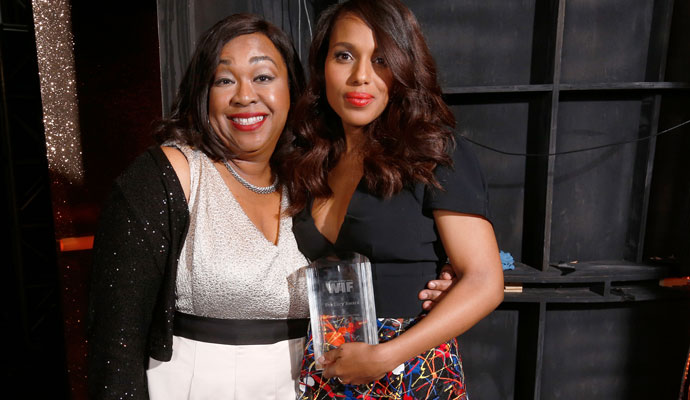Girls on Film: 5 ways movies can be as diverse as television
The success of shows like Orange of the New Black proves that diversity isn't just important — it's profitable


Last Saturday, Orange is the New Black actress Uzo Aduba was named "Outstanding Guest Actress in a Comedy Series" at the Creative Arts Emmys. Her win — and the soaring success of Orange is the New Black in general — is the latest sign that television continues to far outpace the Hollywood film industry when it comes to diversity.
As Aduba tells it, she had just quit the business when she got the role of Suzanne "Crazy Eyes" Warren. "The day — the very day — I got this job, I had quit acting about an hour beforehand," she said in an interview with Today. "I had been trying for [TV roles] and been hearing no."
Showrunner Jenji Kohan built Orange is the New Black as a Trojan Horse — and it worked. She wanted to "sell a show on really fascinating tales of black women, and Latina women, and old women, and criminals," and knew she couldn't unless she used "this white girl, this sort of fish out of water" to lead the viewer into the larger narrative. With a cast boasting untold diversity in race, age, gender, and size, Orange is the New Black is Netflix's most popular program. Aduba's is one of nine Emmy nominations, including another Guest Actress nomination for Laverne Cox, a trans woman of color, a directorial nod for Jodie Foster, and the first-ever Emmy nomination for 59-year-old Kate Mulgrew.
The Week
Escape your echo chamber. Get the facts behind the news, plus analysis from multiple perspectives.

Sign up for The Week's Free Newsletters
From our morning news briefing to a weekly Good News Newsletter, get the best of The Week delivered directly to your inbox.
From our morning news briefing to a weekly Good News Newsletter, get the best of The Week delivered directly to your inbox.
Television is, of course, still far from perfect. Orange is the New Black might be redefining audience interest, but it's still led by an attractive white star, and it focuses on minorities in prison instead of the world at large. And as impressive as it is, Orange is the New Black can't remain an outlier; television must continue to evolve.
But by that same token, Hollywood must take a cue from television — not just as an ideological imperative, but a financial one. Instead of stubbornly ignoring the problem, or pushing it to a future that never seems to come, the film industry can learn a lot from television, which is proving that success lies beyond the white male norm. Here's how:
1. Hire diverse showrunners and directors

Mentorship is essential to the growth of new talent. But while cinema has many male talents who funnel opportunities to up-and-coming directors, there are no leading female auteurs in similar positions. In television, however, two of television's leading showrunners are not only women, but women of color. Shonda Rhimes (Grey's Anatomy, Scandal) and Jenji Kohan (Weeds, Orange is the New Black) don't just have a track record in popular television — they've also led the charge with diverse narratives, hooking audiences while challenging the status quo.
A free daily email with the biggest news stories of the day – and the best features from TheWeek.com
Their burgeoning TV empires have been matched by women getting the opportunity to create their own material — Mindy Kaling (The Mindy Project), Lena Dunham (Girls), Tina Fey (30 Rock), and Amy Schumer (Inside Amy Schumer) — as well as craft shows for other women, like Liz Meriwether (New Girl), Veena Sud (The Killing), Jenny Bicks (Men in Trees), and Amy Sherman-Palladino (Gilmore Girls and Bunheads).
Female directors still struggle for opportunity — even on television — but there are some that defeat the odds. Michelle MacLaren "has become a trademark of quality;" she helmed more episodes of Breaking Bad than any other director, including the Emmy-nominated "Gliding Over All," and has a hand in dramas including The Walking Dead, Game of Thrones, and The Leftovers. Lesli Linka Glatter is the second-most prolific director on Homeland, and has helmed episodes for countless shows, from Twin Peaks to Gilmore Girls to Mad Men.
2. Support projects with leading ladies
Slowly, Hollywood is remembering that cinema can be led by women, from Sandra Bullock's turn in Gravity to Angelina Jolie's embodiment of Maleficent. But these strides are still well behind television, in which many of last year's top 50 shows had female stars (The Good Wife, Bones, Scandal, 2 Broke Girls) or female co-leads (Castle, Elementary, Agents of S.H.I.E.L.D.). The femme-centric numbers continue to grow with network sitcoms (Parks and Rec, Mindy Project, Cougar Town, New Girl), cable offerings (Homeland, Masters of Sex, Veep), and streaming options (Orange is the New Black, The Killing).
The film industry's biggest problem is its failure to offer access to films starring women. As of this week, two Scarlett Johansson films bookend the year's 100 highest-grossing films — Captain America: The Winter Soldier is number one, and Under the Skin is number 100. But the chart isn't a measure of value; it's a measure of access. Captain America opened in 3,938 theaters, averaging $24,000 per theater; Under the Skin opened in only four, but averaged $33,000 per theater. Of the last 10 films on the list, which includes Obvious Child's three-screen opening, only Veronica Mars and The Fluffy Movie had openings that reached triple digits — and only two more opened on more than 10 screens.
In contrast, any television viewer has access to a myriad of leading ladies.
3. Depict women with professional power
In the top four female-centric films of this summer — Maleficent, The Fault in Our Stars, Lucy, and Tammy — the women are a vengeful mother-figure, a dying student, a promiscuous student-turned-medically-advanced superbeing, and a newly jobless wife whose husband cheats on her. Of the top four female-centric shows of the last season's Top 50 — Grey's Anatomy, Scandal, The Good Wife, and Once Upon a Time — the women play doctors, crisis managers, lawyers, and bounty hunters.
Hollywood, quite simply, is barely interested in showing women in a work environment, let alone following a story about womens' professional lives. There was a time in the '80s when professional women were all the rage (from 9 to 5 to Working Girl). Now, those roles have migrated to the small screen: Glenn Close in Damages, Allison Janney in The West Wing, Candice Bergen in Boston Legal, Emily Deschanel on Bones, and Chandra Wilson in Grey's Anatomy.
4. Push female interaction

Because television is willing to explore women working — as well as going to school and becoming wives and mothers — the format routinely passes the Bechdel Test. When narratives starring multiple women focus on something other than romance and motherhood, the women will talk about something other than men.
With this simple requirement met, television creatives can then focus on deepening the interactions — the Meredith/Christina friendship that became so central to Grey's Anatomy, or the many women connecting with each other in Orange is the New Black. In Hollywood, however, such things are so rare that The Heat — a simple buddy-cop film — was treated as groundbreaking.
5. Offer character diversity
Television, like all media, is still primarily the domain of thin, young white women — but the tide is turning. Rhimes and Kohan both use white women (Ellen Pompeo, Kate Walsh, Mary-Louise Parker) to diversify ensembles with talents like Sandra Oh, Audra McDonald, Tonye Patano, Dascha Polanco, and Laverne Cox.
They are joined by shows like Bones (Tamara Taylor, Michaela Conlin), Person of Interest (Taraji P. Henson, Sarah Shahi), Sleepy Hollow (Nicole Beharie), and Elementary (Lucy Liu) that feature strong women of color. TV is also a much more inclusive playing field for varied body shapes: Drop Dead Diva's Brooke Elliott, Mike and Molly's Melissa McCarthy, Super Fun Night's Rebel Wilson. In recent years, there have been strong ensemble roles for women like Yvette Nicole Brown, Retta, Gabourey Sidibe, and Kirsten Vangsness, and a larger variety of options for older actresses (Allison Janney, Jessica Lange, and Angela Bassett).
Film, again, is a different story. Of the 20 most popular films this summer, the only women of color in leading roles are Zoe Saldana — who plays a green-skinned alien in Guardians of the Galaxy — and the women of Think Like a Man 2. America Ferrera and Regina King did voice work in animated films; the only other actress of color with any prominence was Halle Berry in the massive ensemble of X-Men: Days of Future Past.
When Steve Harvey — a man who warns against women who are too educated or independent — is the best option for cinematic diversity, mainstream film is very, very broken. The rampant success of Orange is the New Black and the many other shows with leading, diverse women proves that there is a lot to be gained — both monetarily and societally — in diversifying Hollywood. If the industry would only notice.
Girls on Film is a weekly column focusing on women and cinema. It can be found at TheWeek.com every Friday morning. And be sure to follow the Girls on Film Twitter feed for additional femme-con.
Monika Bartyzel is a freelance writer and creator of Girls on Film, a weekly look at femme-centric film news and concerns, now appearing at TheWeek.com. Her work has been published on sites including The Atlantic, Movies.com, Moviefone, Collider, and the now-defunct Cinematical, where she was a lead writer and assignment editor.
-
 Political cartoons for January 3
Political cartoons for January 3Cartoons Saturday's political cartoons include citizen journalists, self-reflective AI, and Donald Trump's transparency
-
 Into the Woods: a ‘hypnotic’ production
Into the Woods: a ‘hypnotic’ productionThe Week Recommends Jordan Fein’s revival of the much-loved Stephen Sondheim musical is ‘sharp, propulsive and often very funny’
-
 ‘Let 2026 be a year of reckoning’
‘Let 2026 be a year of reckoning’Instant Opinion Opinion, comment and editorials of the day
